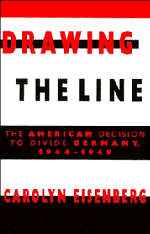Book contents
- Frontmatter
- Contents
- Preface and Acknowledgments
- Germany – Occupation Zones, 1945
- Introduction: Private Polowsky's Oath
- 1 Plans
- 2 Making Peace
- 3 The Limits of Reform: The U.S. Zone
- 4 A Fragile Friendship
- 5 The Russian Challenge
- 6 Bizonal Beginnings
- 7 The Doctors Deliberate
- 8 Marshall's Medicine
- 9 A Separate State
- 10 Cold War Germany
- 11 Winning
- Conclusion: The American Decision to Divide Germany
- Bibliography
- Index
8 - Marshall's Medicine
Published online by Cambridge University Press: 07 October 2009
- Frontmatter
- Contents
- Preface and Acknowledgments
- Germany – Occupation Zones, 1945
- Introduction: Private Polowsky's Oath
- 1 Plans
- 2 Making Peace
- 3 The Limits of Reform: The U.S. Zone
- 4 A Fragile Friendship
- 5 The Russian Challenge
- 6 Bizonal Beginnings
- 7 The Doctors Deliberate
- 8 Marshall's Medicine
- 9 A Separate State
- 10 Cold War Germany
- 11 Winning
- Conclusion: The American Decision to Divide Germany
- Bibliography
- Index
Summary
The difficulty under which we labor is that in spite of our announced position, we really do not want nor intend to accept German unification in any terms that the Russians might agree to, even though they seemed to meet most of our requirements, since as they have declared war on European recovery, we know … that they would … prevent the resources of Germany from contributing.
(Walter Bedell Smith to Eisnhower, December 10, 1947).It is now known that there is an intention to make Germany, or at least western Germany, the object of a definite American plan in Europe. … Germany's affairs are judged and decided by American Senators and American businessmen of every description who boss it in the Western zones and help the American monopolists to penetrate ever deeper into the industries and banks of Western Germany.
(V. M. Molotov, Statement to Soviet Press, December 31, 1947).With the collapse of the Moscow conference, U.S. officials felt they could finally deal with the problem of European recovery. Even before the meeting, they had begun to envision a new economic assistance program that would include Germany. They could now incorporate the western zones, without either the constraints of Potsdam or Soviet interference. Such advantages seemed to overshadow the forfeit of the eastern zone.
By summer, the Americans were discovering that the movement toward partition did not immediately ease the task in western Germany. In elaborating their economic agenda, they were challenged by the French, who still wished to block German industrial revival. They also faced serious opposition from the British, who in association with the German SPD and the trade unions, were pressing for socialization and expanded worker rights.
- Type
- Chapter
- Information
- Drawing the LineThe American Decision to Divide Germany, 1944–1949, pp. 318 - 362Publisher: Cambridge University PressPrint publication year: 1996



